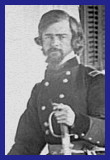DEPARTMENT of RHODE ISLAND
SONS of UNION VETERANS of the
CIVIL WAR
Commodore Joel Abbot, Camp No. 21

Major General Isaac Ingalls Stevens
Isaac Ingalls Stevens was born in Andover, Massachusetts, in 1817. He graduated at West Point in 1839, ranking first in his class, and was commissioned second lieutenant in the Corps of Engineers. In 1840 he was promoted to first lieutenant and was employed upon the fortifications of the New England coast until the Mexican war at that time being adjutant of engineers. He was attached to General Scott's staff and for gallant and meritorious conduct at the battles of Contreras and Churubusco was brevetted Captain. He was brevetted Major for his heroic conduct at the storming of Chapultepec and the city of Mexico, where he received a severe wound from which he never fully recovered.
Upon his return to the United States he was selected by Professor Bache, also a West Point graduate, to perform the duties of chief of the coast survey at Washington. In 1853 he resigned his commission and accepted the appointment of governor of Washington territory, where he became known as an able executive officer, displaying the most unremitting devotion to the interests of the territory. During the administration of President Buchanan he represented Washington territory as delegate in Congress for two terms. He was the chairman of the Breckinridge executive committee in the presidential campaign of 1860. But when the Southern leaders declared for secession he openly denounced them and stood by the Federal government, strongly urging President Buchanan to remove Secretaries Floyd and Thompson from the cabinet and trust to the counsels of General Scott. At the close of the session of Congress Governor Stevens proceeded to Washington territory, but upon hearing of the attack upon Fort Sumter returned to Washington and offered his services to the government.
He was appointed Colonel of the 79th New York Highlander regiment. He was commissioned Brigadier General of volunteers on September 28th, 1861, and accompanied General Sherman to South Carolina where he bore a prominent part in all the battles near Port Royal. He was then transferred to North Carolina, whence he came to Virginia in the corps of General Reno and was promoted to the rank of Major General of Volunteers, his commission bearing date of July 4, 1862. He was in all the skirmishes along the Rappahannock under General Pope and fought most gallantly in the battle of Chantilly, where he was killed September 1st, 1862.
Source: The Union Army A History of Military Affairs in the Loyal States 1861-65 -- Records of the Regiments in the Union Army -- Cyclopedia of Battles -- Memoirs of Commanders and Soldiers. 8 vols. Madison: Federal Publishing, 1908.
More information:
At the First Battle of Bull Run, the 79th had lost Colonel James Cameron. During a sideline to the Battle of Second Bull Run, known as the Battle of Chantilly, the 79th lost Cameron's replacement, General Isaac Stevens. Four standard bearers of the 79th were shot down in succession. General Stevens leaped from his horse, took hold of the St. Andrew's Cross, and shouted, "Follow me my Highlanders! Follow your general!" Then he too fell to a bullet. Reports state that as he fell, the banner covered his body like a shroud. After their beloved general fell, the enraged Highlanders rushed forward, and routed the Confederates. Newspapers of the period wrongly depicted General Stevens carrying the Stars and Stripes, and not the Saltire.
Stevensí son, Brevet Brigadier General Hazard Stevens, was twice injured at Ox Hill and recieved the Medal of Honor.
Click HERE to view a map of Island Cemetery.
Sign Our Guestbook | View Our Guestbook
"Lest We Forget"
Website created and maintained by Kenneth R. Lucier